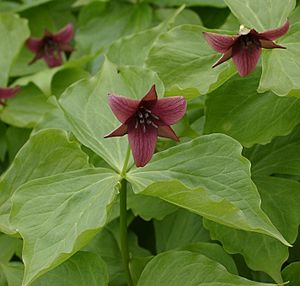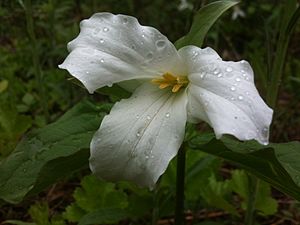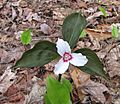Trillium facts for kids
Quick facts for kids Trillium |
|
|---|---|
 |
|
| Trillium erectum (red trillium) | |
| Scientific classification |
|
| Kingdom: | Plantae |
| Clade: | Tracheophytes |
| Clade: | Angiosperms |
| Clade: | Monocots |
| Order: | Liliales |
| Family: | Melanthiaceae |
| Tribe: | Parideae |
| Genus: | Trillium L. |
| Type species | |
| Trillium cernuum |
|
| Synonyms | |
|
|
Trillium (also known as wakerobin, tri flower, or birthroot) is a group of about 50 different types of flowering plants. These plants belong to the family Melanthiaceae. Trilliums grow naturally in cooler parts of North America and Asia. You can find the most kinds of trilliums in the southern Appalachian Mountains in the southeastern United States.
Contents
What Trilliums Look Like
Trillium plants are perennial herbs. This means they live for more than two years and have soft stems, not woody ones. They grow from underground stems called rhizomes.
Each trillium plant has three large, leaf-like parts called bracts. These bracts grow in a circle around a stem that comes straight up from the rhizome. While they look like leaves, they are not true leaves. However, they do perform photosynthesis, which means they make food for the plant using sunlight.
The plant usually has one single flower. This flower has three green or reddish parts called sepals. It also has three colorful petals that can be red, purple, pink, white, yellow, or green. In the center of the flower, there are six stamens (which make pollen) and three stigmas (which receive pollen). The fruit of the trillium is soft and can look like a capsule or a berry. The seeds inside have special oily parts called elaiosomes.
Sometimes, a trillium plant might have four bracts, four sepals, and four petals instead of the usual three. This is less common but can happen!
How Trilliums Are Classified
In 1753, a Swedish scientist named Carl Linnaeus first named the Trillium group of plants. He identified three types: T. cernuum, T. erectum, and T. sessile.
For a long time, trilliums were placed in a large plant family called Liliaceae. But scientists later realized that this family was too big and contained many different kinds of plants. So, in 1998, the Angiosperm Phylogeny Group decided to place Trillium and some similar plants into the family Melanthiaceae.
Scientists often divide the Trillium group into two main smaller groups. One group has flowers that grow on a short stalk (called pedicellate flowers). The other group has flowers that sit directly on the plant without a stalk (called sessile flowers).
North American Trillium Species
Here are some of the trillium species found in North America. They are divided into two groups based on their flowers and leaves.
The following species have flowers on a short stalk and do not have spotted leaves:
- Trillium catesbaei – Found in Alabama, Georgia, North Carolina, South Carolina, Tennessee.
- Trillium cernuum – Found across many parts of Canada and the eastern U.S.
- Trillium erectum – Found in eastern Canada and many eastern U.S. states.
- Trillium flexipes – Found in Ontario, Canada, and several U.S. states.
- Trillium grandiflorum – Found in eastern Canada and many eastern U.S. states.
- Trillium nivale – Found in several central and eastern U.S. states.
- Trillium ovatum – Found in western Canada and western U.S. states.
- Trillium persistens – Found in Georgia, South Carolina.
- Trillium pusillum – Found in many southern and eastern U.S. states.
- Trillium rugelii – Found in Alabama, Georgia, North Carolina, South Carolina, Tennessee.
- Trillium simile – Found in Georgia, North Carolina, Tennessee.
- Trillium sulcatum – Found in Alabama, Georgia, Kentucky, North Carolina, Tennessee, Virginia, West Virginia.
- Trillium texanum – Found in Louisiana, Texas.
- Trillium undulatum – Found in eastern Canada and many eastern U.S. states.
- Trillium vaseyi – Found in Alabama, Georgia, North Carolina, South Carolina, Tennessee.
The following species have flowers that sit directly on the plant (no stalk) and often have spotted leaves:
- Trillium albidum – Found in California, Oregon, Washington.
- Trillium angustipetalum – Found in California.
- Trillium chloropetalum – Found in California.
- Trillium cuneatum – Found in Alabama, Georgia, Kentucky, Mississippi, North Carolina, South Carolina, Tennessee.
- Trillium decipiens – Found in Alabama, Florida, Georgia.
- Trillium decumbens – Found in Alabama, Georgia, Tennessee.
- Trillium discolor – Found in Georgia, North Carolina, South Carolina.
- Trillium foetidissimum – Found in Louisiana, Mississippi.
- Trillium gracile – Found in Louisiana, Texas.
- Trillium kurabayashii – Found in California, Oregon.
- Trillium lancifolium – Found in Alabama, Florida, Georgia, South Carolina, Tennessee.
- Trillium ludovicianum – Found in Louisiana, Mississippi, Texas.
- Trillium luteum – Found in Georgia, Kentucky, North Carolina, Tennessee.
- Trillium maculatum – Found in Alabama, Florida, Georgia, South Carolina.
- Trillium oostingii – Found in South Carolina.
- Trillium petiolatum – Found in Idaho, Oregon, Washington.
- Trillium recurvatum – Found in many central and southern U.S. states.
- Trillium reliquum – Found in Georgia, South Carolina.
- Trillium sessile – Found in many central and eastern U.S. states.
- Trillium stamineum – Found in Alabama, Mississippi, Tennessee.
- Trillium tennesseense – Found in Tennessee.
- Trillium underwoodii – Found in Alabama, Florida, Georgia.
- Trillium viride – Found in Illinois, Missouri.
- Trillium viridescens – Found in Arkansas, Kansas, Missouri, Oklahoma, Texas.
Asian Trillium Species
All of the following species found in Asia have flowers that grow on a short stalk:
- Trillium apetalon – Found in Japan, Kuril Islands, Eastern Russia.
- Trillium camschatcense – Found in Northeast China, Japan, Korea, Kuril Islands, Eastern Russia.
- Trillium channellii – Found in Japan (Eastern Hokkaido).
- Trillium govanianum – Found in Northeast Afghanistan, Bhutan, China, Northern India, Nepal, Northern Pakistan.
- Trillium × hagae – Found in Japan, Eastern Russia.
- Trillium × komarovii – Found in Japan, Eastern Russia.
- Trillium × miyabeanum – Found in Japan.
- Trillium smallii – Found in Japan, Eastern Russia.
- Trillium taiwanense – Found in Eastern Taiwan.
- Trillium tschonoskii – Found in Bhutan, China, Northeast India, Japan, Korea, Kuril Islands, Myanmar, Russia, Taiwan.
- Trillium × yezoense – Found in Japan.
Where Trilliums Grow
Trillium plants grow naturally in North America and Asia.
North America
More than 36 types of trilliums are found in North America. Most of these grow in the eastern part of the continent. Only six species grow in western North America: T. albidum, T. angustipetalum, T. chloropetalum, T. kurabayashii, T. ovatum, and T. petiolatum. Among these, only T. ovatum has flowers on a stalk.
Canada
You can find trillium species all across Canada, from Newfoundland to southern British Columbia. The most different kinds of trilliums are found in Ontario, Quebec, and Nova Scotia.
- Alberta: T. ovatum
- British Columbia: T. ovatum
- Manitoba: T. cernuum
- New Brunswick: T. cernuum, T. erectum, T. undulatum
- Newfoundland: T. cernuum
- Nova Scotia: T. cernuum, T. erectum, T. grandiflorum, T. undulatum
- Ontario: T. cernuum, T. erectum, T. flexipes, T. grandiflorum, T. undulatum
- Prince Edward Island: T. cernuum, T. undulatum
- Quebec: T. cernuum, T. erectum, T. grandiflorum, T. undulatum
- Saskatchewan: T. cernuum
United States
Trillium species grow throughout the contiguous U.S. states, except for the desert areas in the southwest. In the western United States, they are found from Washington to central California, stretching east to the Rocky Mountains. In the eastern United States, they grow from Maine to northern Florida, and west to the Mississippi River valley.
The southeastern United States has a lot of different trillium species. Georgia, Tennessee, Alabama, North Carolina, and South Carolina are especially rich in these plants. Georgia alone is home to 19 different types of trillium!
- Alabama: T. catesbaei, T. cuneatum, T. decipiens, T. decumbens, T. flexipes, T. grandiflorum, T. lancifolium, T. maculatum, T. pusillum, T. recurvatum, T. rugelii, T. sessile, T. stamineum, T. sulcatum, T. underwoodii, T. vaseyi
- Arkansas: T. pusillum, T. recurvatum, T. sessile, T. viridescens
- California: T. albidum, T. angustipetalum, T. chloropetalum, T. kurabayashii, T. ovatum
- Colorado: T. ovatum
- Connecticut: T. cernuum, T. erectum, T. grandiflorum, T. undulatum
- Delaware: T. cernuum, T. erectum, T. flexipes, T. grandiflorum
- District of Columbia: T. cernuum
- Florida: T. decipiens, T. lancifolium, T. maculatum, T. underwoodii
- Georgia: T. catesbaei, T. cuneatum, T. decipiens, T. decumbens, T. discolor, T. erectum, T. grandiflorum, T. lancifolium, T. luteum, T. maculatum, T. persistens, T. pusillum, T. reliquum, T. rugelii, T. simile, T. sulcatum, T. underwoodii, T. undulatum, T. vaseyi
- Idaho: T. ovatum, T. petiolatum
- Illinois: T. cernuum, T. erectum, T. flexipes, T. grandiflorum, T. nivale, T. recurvatum, T. sessile, T. viride
- Indiana: T. cernuum, T. erectum, T. flexipes, T. grandiflorum, T. nivale, T. recurvatum, T. sessile
- Iowa: T. cernuum, T. flexipes, T. grandiflorum, T. nivale, T. recurvatum
- Kansas: T. sessile, T. viridescens
- Kentucky: T. cuneatum, T. erectum, T. flexipes, T. grandiflorum, T. luteum, T. nivale, T. pusillum, T. recurvatum, T. sessile, T. sulcatum, T. undulatum
- Louisiana: T. foetidissimum, T. gracile, T. ludovicianum, T. pusillum, T. recurvatum
- Maine: T. cernuum, T. erectum, T. grandiflorum, T. undulatum
- Maryland: T. cernuum, T. erectum, T. flexipes, T. grandiflorum, T. nivale, T. pusillum, T. sessile, T. undulatum
- Massachusetts: T. cernuum, T. erectum, T. grandiflorum, T. undulatum
- Michigan: T. cernuum, T. erectum, T. flexipes, T. grandiflorum, T. nivale, T. recurvatum, T. sessile, T. undulatum
- Minnesota: T. cernuum, T. flexipes, T. grandiflorum, T. nivale
- Mississippi: T. cuneatum, T. foetidissimum, T. ludovicianum, T. pusillum, T. recurvatum, T. stamineum
- Missouri: T. flexipes, T. nivale, T. pusillum, T. recurvatum, T. sessile, T. viride, T. viridescens
- Montana: T. ovatum
- Nebraska: T. nivale
- New Hampshire: T. cernuum, T. erectum, T. grandiflorum, T. undulatum
- New Jersey: T. cernuum, T. erectum, T. grandiflorum, T. undulatum
- New York: T. cernuum, T. erectum, T. flexipes, T. grandiflorum, T. sessile, T. undulatum
- North Carolina: T. catesbaei, T. cuneatum, T. discolor, T. erectum, T. grandiflorum, T. luteum, T. pusillum, T. rugelii, T. sessile, T. simile, T. sulcatum, T. undulatum, T. vaseyi
- North Dakota: T. cernuum
- Ohio: T. cernuum, T. erectum, T. flexipes, T. grandiflorum, T. nivale, T. recurvatum, T. sessile, T. undulatum
- Oklahoma: T. pusillum, T. sessile, T. viridescens
- Oregon: T. albidum, T. kurabayashii, T. ovatum, T. petiolatum
- Pennsylvania: T. cernuum, T. erectum, T. flexipes, T. grandiflorum, T. nivale, T. sessile, T. undulatum
- Rhode Island: T. cernuum, T. erectum, T. undulatum
- South Carolina: T. catesbaei, T. cuneatum, T. discolor, T. erectum, T. grandiflorum, T. lancifolium, T. maculatum, T. persistens, T. pusillum, T. reliquum, T. rugelii, T. undulatum, T. vaseyi
- South Dakota: T. cernuum, T. flexipes, T. nivale
- Tennessee: T. catesbaei, T. cuneatum, T. decumbens, T. erectum, T. flexipes, T. grandiflorum, T. lancifolium, T. luteum, T. pusillum, T. recurvatum, T. rugelii, T. sessile, T. simile, T. stamineum, T. sulcatum, T. tennesseense, T. undulatum, T. vaseyi
- Texas: T. gracile, T. ludovicianum, T. pusillum, T. recurvatum, T. viridescens
- Vermont: T. cernuum, T. erectum, T. grandiflorum, T. undulatum
- Virginia: T. cernuum, T. erectum, T. flexipes, T. grandiflorum, T. pusillum, T. sessile, T. sulcatum, T. undulatum
- Washington: T. albidum, T. ovatum, T. petiolatum
- West Virginia: T. cernuum, T. erectum, T. flexipes, T. grandiflorum, T. nivale, T. pusillum, T. sessile, T. sulcatum, T. undulatum
- Wisconsin: T. cernuum, T. flexipes, T. grandiflorum, T. nivale, T. recurvatum
- Wyoming: T. ovatum
Asia
In Asia, trillium species stretch from the Himalayas across China, Korea, Japan, and eastern Russia to the Kuril Islands. Japan and Sakhalin islands have the most different kinds of trilliums.
- Afghanistan: T. govanianum
- Bhutan: T. govanianum, T. tschonoskii
- China: T. camschatcense (Jilin), T. govanianum (Tibet Autonomous Region, Yunnan), T. taiwanense (Eastern Taiwan), T. tschonoskii (Anhui, Fujian, Gansu, Hubei, Shaanxi, Sichuan, Tibet Autonomous Region, Yunnan, Zhejiang)
- India: T. govanianum (Himachal Pradesh, Jammu and Kashmir, Sikkim, Uttarakhand), T. tschonoskii (Sikkim)
- Japan: T. apetalon, T. camschatcense, T. channellii (Hokkaido), T. × hagae, T. × komarovii, T. × miyabeanum, T. smallii, T. tschonoskii, T. × yezoense
- Korea: T. camschatcense, T. tschonoskii
- Kuril Islands: T. apetalon, T. camschatcense, T. tschonoskii
- Myanmar: T. tschonoskii
- Nepal: T. govanianum
- Pakistan: T. govanianum
- Russia: T. apetalon (Sakhalin), T. camschatcense (Primorsky Krai, Khabarovsk Krai, Kamchatka Peninsula, Sakhalin), T. × hagae (Sakhalin), T. × komarovii (Primorsky Krai), T. smallii (Sakhalin), T. tschonoskii (Sakhalin)
- Taiwan: T. taiwanense, T. tschonoskii
How to Identify Trilliums
To figure out what kind of trillium you're looking at, it's best to see a mature plant with a flower. The first step is to check if the flower has a small stalk (a pedicel) or if it sits directly on the plant. This helps you know which main group it belongs to. After that, you can look at the flower parts, the shape of the leaves, and other features. You usually need to look at a few different things to identify the exact species.
It can be tricky to identify a trillium if it doesn't have flowers or fruit. Even though some trilliums have leaf stalks or unique leaf shapes, these features are often not enough to tell the species apart.
In eastern North America, a plant called jack-in-the-pulpit (Arisaema triphyllum) is sometimes confused with trilliums. Both plants are about the same height and have leaves divided into three parts. However, jack-in-the-pulpit leaves are arranged differently and have different vein patterns than trillium leaves.
Ecology and Seed Dispersal
Trilliums have a special way of spreading their seeds called myrmecochory. This means that ants help to spread the seeds! Ants are attracted to the large, oily parts on the seeds called elaiosomes. They collect the seeds and carry them away from the parent plant. For example, ants like Aphaenogaster smythiesi and Myrmica ruginodis collect the seeds of Trillium camschatcense and T. tschonoskii.
Sometimes, beetles might eat the elaiosomes, making the seeds less appealing to ants. Another way seeds are spread is by certain types of yellow jacket hornets (Vespula species). These insects also carry the seeds away to eat the elaiosomes.
Protecting Trilliums

Picking parts off a trillium plant can actually kill it, even if the underground part (rhizome) is left alone. This is because the plant needs its leaves to make food. Some trillium species are considered threatened or endangered, which means they are at risk of disappearing. Because of this, collecting these rare species might be against the law.
Laws in some places might also limit how trilliums can be sold or harvested. They might also say you can't collect them without the landowner's permission. In the U.S. states of Michigan and Minnesota, it is illegal to pick trilliums. In New York, it is illegal to pick the red trillium.
In Ontario, Canada, there was a proposal to make it illegal to harm the common Trillium grandiflorum (white trillium), but this law was not passed. However, the rare Trillium flexipes (drooping trillium) is protected by law in Ontario because its population in Canada is shrinking.
A large number of white-tailed deer in an area can also harm trillium populations. They often eat the plants, especially the white trillium, which can cause the plants to decrease or disappear.
Some trillium species are collected too much from the wild, which is not good for their survival. This is a big problem for T. govanianum. This plant is sold for a high price as a traditional medicine. People collecting it have sometimes damaged large areas of sensitive Himalayan forests, which has even led to mudslides.
Traditional Uses
Some trillium species contain natural compounds called sapogenins. Historically, these plants were used in traditional medicine to help with childbirth, which is why they are sometimes called "birthwort" or "birthroot." In 1918, a publication by Joseph E. Meyer mentioned "beth root" (likely a changed form of "birthroot"). He said that a strong liquid made from the root could help stop bleeding and diarrhea.
Trilliums in Culture
The white trillium (Trillium grandiflorum) is the official flower and symbol of the Canadian province of Ontario. It is an important symbol for the Government of Ontario. The large white trillium is also the official wildflower of Ohio in the U.S. Because both Ontario and Ohio share this flower as a symbol, the Major League Soccer teams from Toronto and Columbus compete for the Trillium Cup.
People who are citizen scientists often share their observations of trillium species from all over the world. The most commonly observed trillium species are T. grandiflorum, T. erectum, and T. ovatum.
Trillium is also the name of the literary magazine at Ramapo College of New Jersey. It features poems, stories, photos, and other art created by students at the college.
Gallery
-
Nodding trillium (Trillium cernuum)
-
Idaho trillium (Trillium petiolatum)
-
White trillium (Trillium grandiflorum)
-
Red trillium (Trillium erectum)
-
Pacific trillium (Trillium ovatum)
-
Prairie trillium (Trillium recurvatum)
-
Relict trillium (Trillium reliquum) an endangered species
-
Painted trillium (Trillium undulatum)
See also
 In Spanish: Trillium para niños
In Spanish: Trillium para niños









